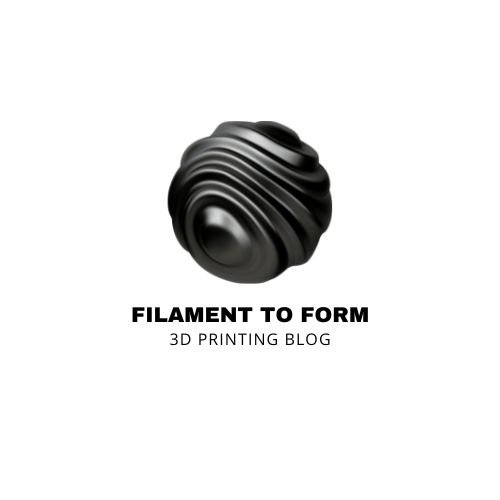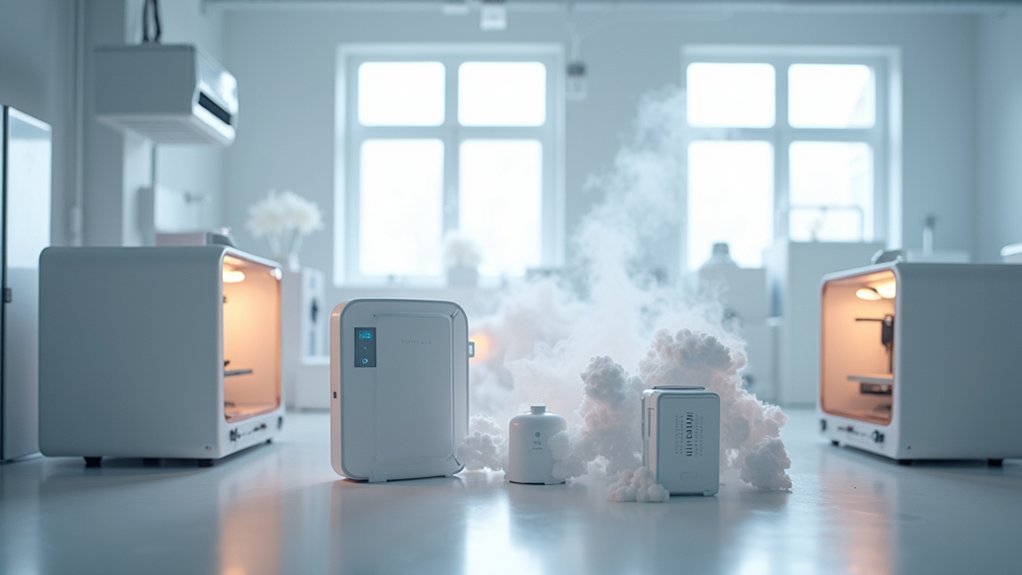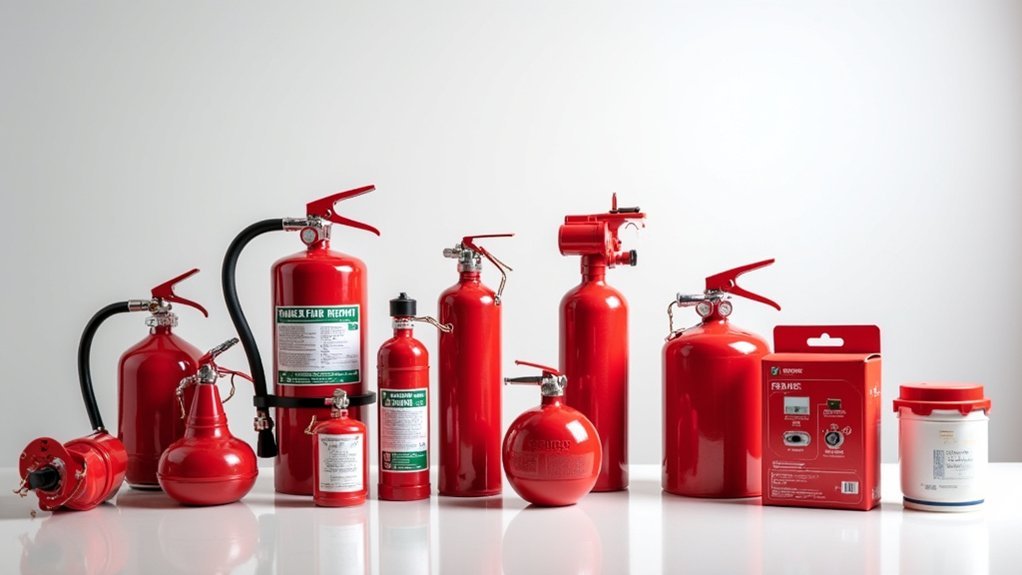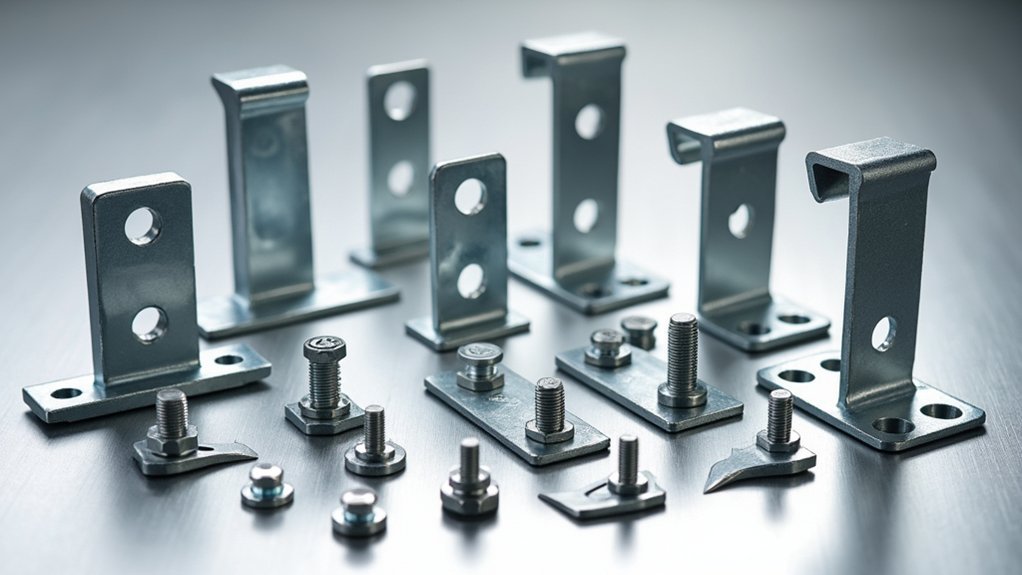You’ve probably experienced the acrid smell and visible fumes that escape from your 3D printer during those long print jobs. Whether you’re working with PLA, ABS, or resin materials, these emissions can impact your health and workspace comfort over time. The right air filtration system doesn’t just clear the air—it protects your lungs and creates a more pleasant printing environment. But with dozens of options claiming to be the best, how do you choose the system that’ll actually deliver results?
VEWIOR H13 True HEPA Air Purifier for Large Rooms up to 2535ft²
If you’re running a 3D printer in a large workspace or home office up to 2,535 square feet, the VEWIOR H13 True HEPA Air Purifier delivers the industrial-strength filtration you need to capture ultrafine particles and toxic fumes. Its 3-stage system filters 99.97% of particles as small as 0.1 microns, including harmful printing emissions. The real-time PM2.5 sensor automatically adjusts fan speed based on air quality, while whisper-quiet operation at 20dB won’t disrupt your workflow. With 5X air circulation per hour, timer settings, and a washable pre-filter, it’s built for continuous operation in demanding printing environments.
Best For: Large workspace owners, 3D printer enthusiasts, and professionals who need industrial-strength air filtration to capture ultrafine particles and toxic fumes in spaces up to 2,535 square feet.
Pros:
- Captures 99.97% of particles as small as 0.1 microns with H13 True HEPA filtration, effectively removing harmful printing emissions and ultrafine particles
- Real-time PM2.5 sensor with auto mode intelligently adjusts fan speed based on air quality for optimal performance without manual intervention
- Whisper-quiet operation at 20dB with 5X air circulation per hour ensures continuous filtration without disrupting workflow in professional environments
Cons:
- Filter replacement required every 3-6 months which adds ongoing maintenance costs for continuous heavy-duty use
- Large coverage area may mean higher initial investment compared to smaller capacity air purifiers
- Essential oils for aromatherapy feature are not included and must be purchased separately
Abestorm Tabletop Dust Collector for Woodworking with Timer Function
When you’re operating a 3D printer in a small workshop or garage, the Abestorm Tabletop Dust Collector for Woodworking with Timer Function offers an efficient solution for capturing airborne particles and improving air quality. This portable 20.1-pound unit delivers 580-780 CFM airflow with dual speed settings and operates on just 100 watts. You’ll appreciate the timer function up to 120 minutes and piano key switch for easy operation. The MERV-13 filter lasts six months, while the sturdy handle and 11.5-foot cord make positioning flexible. At 4.6 stars from users, it’s praised for compactness and low noise operation.
Best For: Small workshop owners, woodworkers, and DIY enthusiasts who need a portable, efficient dust collection solution for improving air quality during projects like 3D printing, woodworking, or renovations.
Pros:
- Compact and portable design with sturdy handle makes it easy to move around small workshops and garages
- Timer function up to 120 minutes and dual speed settings (580-780 CFM) provide flexible operation for different project needs
- Low power consumption at 100 watts with quiet operation and long-lasting MERV-13 filter that lasts up to 6 months
Cons:
- Cannot be shipped to California due to state regulations, limiting availability for some customers
- Some users express concerns about the availability of replacement filters for long-term use
- Limited to smaller spaces and may not provide sufficient airflow for larger workshop environments
ANYCUBIC Mini Purifier 3D Printer Accessories (Pack of 2)
The ANYCUBIC Mini Purifier stands out as an ideal solution for hobbyist 3D printer enthusiasts who need portable odor control without breaking the bank. You’ll appreciate its compact 4.5 x 1.8 x 1.8 inch design that fits anywhere around your printer setup. The built-in rechargeable battery eliminates cord clutter while delivering quiet operation at just 40 decibels. Its 18mm thick activated carbon filter effectively absorbs resin and ABS fumes, lasting 3-6 months before replacement. With 4.5-star ratings from nearly 800 users, this pack of two purifiers provides excellent value for reducing VOCs and maintaining breathable air in your workspace.
Best For: Hobbyist 3D printer users who want an affordable, portable solution to reduce resin and ABS printing odors in small to medium-sized workspaces.
Pros:
- Compact, battery-powered design with quiet operation (≤40 decibels) that can be placed anywhere without cord management
- Effective 18mm thick activated carbon filter that significantly reduces VOCs and resin odors for 3-6 months
- Excellent value with pack of two units, high customer satisfaction (4.5/5 stars), and easy filter replacement
Cons:
- Filters require regular replacement every 3-6 months to maintain effectiveness, adding ongoing costs
- May not eliminate all odors completely and works best when combined with proper ventilation systems
- Limited to small-scale odor control and may not be sufficient for serious hobbyists with heavy printing operations
ELEGOO MARS MATE Air Purifier for 3D Printers
ELEGOO’s MARS MATE Air Purifier stands out as an exceptional choice for resin 3D printer users who demand both superior air quality and whisper-quiet operation. You’ll appreciate its impressive 95% TVOC removal capability while enjoying virtually silent 35dB operation thanks to intelligent fan speed switching. The compact 210x247x410mm unit features durable ABS construction and ultra-low 6W power consumption. You’ll find setup straightforward with broad compatibility across ELEGOO’s Mars, Saturn, and Jupiter series. The built-in VOC sensor monitors air quality and alerts you when it’s time to replace the activated carbon filter after two months of use.
Best For: Resin 3D printer enthusiasts who need effective air purification without noise disruption and want a low-maintenance solution with smart monitoring capabilities.
Pros:
- Removes up to 95% of harmful TVOC emissions with whisper-quiet 35dB operation
- Smart VOC sensor automatically monitors air quality and alerts when filter replacement is needed
- Ultra-low 6W power consumption with broad compatibility across ELEGOO printer series
Cons:
- Activated carbon filters require replacement every 2 months, adding ongoing maintenance costs
- Limited compatibility mainly to ELEGOO printers and others with extension ports
- Compact size may not be suitable for larger workshop spaces or multiple printer setups
ELEGOO Mini Air Purifier with Activated Carbon Filter for Resin 3D Printer (Pack of 2)
Budget-conscious makers who need effective odor control for their resin 3D printing setup will find the ELEGOO Mini Air Purifier an appealing solution. This pack of two units features activated carbon filters that absorb resin odors before they spread, delivering up to 85% odor reduction. Each purifier operates for 24+ hours on its 2000mAh battery and runs quietly enough that you’ll need to check airflow to confirm operation. The replaceable carbon filters last 3-6 months, though finding replacements can be challenging. While effective for small spaces and enclosed printer areas, you’ll want to combine these with proper ventilation for ideal results.
Best For: Budget-conscious resin 3D printer users who need effective odor control in small, enclosed spaces and want the convenience of dual units for continuous operation.
Pros:
- Delivers up to 85% odor reduction with activated carbon filtration and 24+ hours of battery life per charge
- Pack of two units allows alternating use while one charges, ensuring continuous odor control
- Operates quietly and works effectively in enclosed printer spaces and small areas
Cons:
- Replacement carbon filters are difficult to find and must be purchased separately
- May not provide sufficient odor control for larger areas or heavy printing usage without additional ventilation
- Slow charging times and unclear operational indicator lights make status monitoring difficult
Phrozen Air Purifier for LCD 3D Printers (Pack of 2)
Compact design meets powerful performance in the Phrozen Air Purifier, making it perfect for hobbyists and professionals who need portable odor control in tight workspaces. You’ll appreciate its 115x46x46 mm dimensions that won’t clutter your setup while effectively eliminating resin odors during printing.
The filtration system includes four high-density activated carbon filters—two pre-installed and two refills. You’ll experience immediate resin smell reduction thanks to maximum odor adsorption capabilities. The rechargeable 2000 mAH battery delivers efficient 0.6W operation, while silent motors maintain peaceful printing sessions.
This eco-friendly purifier works with most resin printers, including Phrozen’s Sonic Mini and Mighty series, ensuring broad compatibility for your 3D printing needs.
Best For: Hobbyists and professionals using LCD 3D printers who need effective odor control in compact workspaces without sacrificing performance or creating noise disruption.
Pros:
- Compact 115x46x46 mm design with powerful filtration that includes 4 high-density activated carbon filters for maximum odor adsorption
- Rechargeable 2000 mAH battery with efficient 0.6W power consumption and silent motor operation for uninterrupted printing sessions
- Broad compatibility with most resin printers including Phrozen Sonic Mini and Mighty series, plus comes as a 2-pack for multiple setups
Cons:
- Small filter size (39x39x18 mm) may require frequent replacements for heavy printing usage
- Limited to 0.6W power consumption which may not be sufficient for larger printing areas or industrial-scale operations
- Battery-dependent operation means potential downtime during charging periods if not monitored
NANPU Z Series 3-Stage Air Filtration System
The NANPU Z Series 3-Stage Air Filtration System delivers industrial-grade performance that makes it the top choice for serious makers running high-volume 3D printing operations or working with demanding materials. You’ll get three filtration stages—sintered, fine, and activated charcoal filters—that effectively remove contaminants from your workspace air supply.
This system handles up to 218 psi inlet pressure while delivering 127 CFM airflow at 6 bar. The metal housing withstands temperatures up to 248°F, making it perfect for heated printing environments. You’ll appreciate the adjustable outlet pressure up to 145 psi and dual pressure gauges for precise monitoring.
Installation’s straightforward with included mounting brackets and threaded couplings, and users consistently rate it 5 stars for build quality and reliability.
Best For: Professional makers, industrial users, and high-volume 3D printing operations that require reliable contaminant removal from compressed air supply systems.
Pros:
- Three-stage filtration system (sintered, fine, and activated charcoal) effectively removes water and contaminants from air supply
- Robust metal construction withstands high pressures up to 218 psi and temperatures up to 248°F for demanding industrial environments
- High airflow capacity of 127 CFM at 6 bar with adjustable outlet pressure and dual pressure gauges for precise control
Cons:
- Relatively heavy at 12.1 pounds may require secure mounting considerations for some installations
- Different inlet and outlet thread sizes (1/2 NPT to 1/4 NPT) may require additional fittings for some setups
- Limited to 5 customer reviews, providing a smaller sample size for long-term reliability assessment
Upgrade 3-Layers Filter System Smoke Exhaust Kit for Laser Engraver 3D Printer
Makers seeking professional-grade air purification for their workspace will find the Upgrade 3-Layers Filter System an ideal solution for both laser engravers and 3D printer enclosures. You’ll appreciate the powerful 5000 RPM brushless fan that effectively extracts smoke and fumes during printing operations. The three-layer filtration captures large dust particles and harmful gases, creating a healthier environment. You can adjust airflow using the included speed control adapter, which accepts standard AC voltage and outputs 3-12V. Installation requires cutting an opening in your enclosure, and you’ll need to print a plastic adapter to replace the steel bracket using the provided Thingiverse file.
Best For: Makers and hobbyists who use laser engravers or 3D printers in enclosed spaces and need effective smoke and fume extraction to maintain air quality and safety.
Pros:
- Powerful 5000 RPM brushless fan with adjustable speed control for customizable airflow
- Three-layer filtration system effectively captures dust particles and harmful gases
- Compatible with most printer enclosures and includes universal AC power adapter
Cons:
- Requires cutting an opening in your enclosure for installation
- Needs additional 3D printing of a plastic adapter using provided file
- May produce noise at maximum 5000 RPM operation speed
Solder Fume Extractor with Powerful Suction & 3 Layer Filtration
When you’re working with soldering projects, laser engraving, or 3D printing in confined spaces, this Solder Fume Extractor delivers exceptional air purification through its powerful 15,000 RPM motor and advanced 3-layer filtration system. You’ll appreciate its 160m³/h airflow capacity that removes 99.99% of harmful particles, gases, and bacteria while maintaining whisper-quiet operation below 60 dbm. The adjustable hose extends from 7 to 25 inches with 360° rotation, giving you flexible positioning. Its compact metal construction fits easily in your workspace, operating efficiently on 100V-240V power while consistently protecting your health from toxic fumes.
Best For: Hobbyists, electronics technicians, and makers who need effective fume extraction for soldering, 3D printing, or laser engraving in small to medium workspaces.
Pros:
- Powerful 15,000 RPM motor with high 160m³/h airflow capacity removes 99.99% of harmful particles and gases
- Quiet operation under 60 dbm with adjustable hose (7-25 inches) and 360° rotation for flexible positioning
- Compact metal construction with wide voltage compatibility (100V-240V) and efficient 3-layer filtration system
Cons:
- Some user concerns about filter replacement availability and frequency
- Limited mobility due to design, making it less portable for different work areas
- At 3.89 pounds, it may be heavier than expected for a desktop fume extractor
Abestorm 360 Degree Air Filtration System for Woodworking (DecDust 1350IG)
Woodworkers seeking powerful dust collection with 3D printing versatility will find the Abestorm DecDust 1350IG delivers exceptional performance across both applications. This 1350 CFM system covers spaces up to 1700 square feet, featuring 360-degree intake and built-in ionizer technology for enhanced particle capture. You’ll appreciate the flexible installation options—ceiling-hung, workbench-mounted, or direct placement—plus convenient remote control with timer functionality. The MERV-11 filtration handles fine particles effectively, though you’ll need to replace filters every 2-4 months. At 60-69 dBA, it’s reasonably quiet for workshop environments. Users consistently praise its dust removal capabilities and improved air quality results.
Best For: Woodworkers and makers who need powerful dust collection in medium to large workshops up to 1700 square feet and want flexible installation options with remote control convenience.
Pros:
- High 1350 CFM airflow with 360-degree intake effectively captures airborne dust and particles across large workshop spaces
- Versatile installation options including ceiling mount, workbench placement, or direct mounting with included hardware
- Built-in ionizer technology and MERV-11 filtration provide enhanced particle capture and improved air quality
Cons:
- Filters require frequent replacement every 2-4 months and can clog quickly with heavy use
- Cannot be shipped to California due to regulatory restrictions
- Moderate noise level of 60-69 dBA may be noticeable in quieter work environments
Factors to Consider When Choosing Air Filtration Systems for 3D Printing Spaces
When selecting an air filtration system for your 3D printing workspace, you’ll need to evaluate several critical factors that directly impact performance and cost-effectiveness. Your room’s square footage determines the required airflow capacity, while filter efficiency ratings affect how well the system captures ultrafine particles and volatile organic compounds from printing materials. You should also weigh ongoing expenses like power consumption and filter replacement schedules against noise levels that won’t disrupt your printing environment.
Room Size Coverage
Room size coverage determines how effectively your air filtration system will protect you from harmful 3D printing emissions. You’ll need systems designed for larger areas (up to 2,535 sq.ft.) if you’re operating in spacious workshops. Check the airflow capacity measured in cubic feet per minute (CFM) – systems offering 580 to 1350 CFM work best for medium to large spaces to adequately circulate and filter air.
Your air filtration system should match or exceed your room’s volume. Look for systems providing 5X air circulation per hour to maintain ideal air quality in larger environments. For small spaces like 3D printer enclosures, you’ll want compact, efficient systems with powerful filtration targeting specific printing pollutants. Always verify manufacturer specifications for recommended room sizes.
Filter Type Efficiency
Filter efficiency determines your system’s ability to capture harmful particles and gases generated during 3D printing operations. You’ll want to understand different filter types and their specific capabilities when selecting your air filtration system.
HEPA filters, particularly H13 variants, capture 99.97% of particles as small as 0.1-0.3 microns, effectively removing fine dust and airborne contaminants. For VOCs and resin odors, you’ll need activated carbon filters that excel at absorbing these chemical compounds.
MERV-13 filters offer an excellent balance between airflow and particle capture efficiency for general applications. You’ll achieve superior results by combining multiple filter types—pre-filters with activated carbon create thorough protection against various pollutants. This multi-stage approach targets both particulate matter and gaseous contaminants simultaneously, maximizing your system’s overall effectiveness.
Noise Level Requirements
Balancing effective air filtration with a peaceful work environment requires careful consideration of your system’s noise output. You’ll want to target devices operating below 40 dB for minimal workspace disturbance during detailed printing tasks. Air purifiers and dust collectors typically range from 20 dB (whisper-quiet) to 70 dB (normal conversation level), so you’ve got options based on your tolerance and setting requirements.
Systems exceeding 60 dB can become distracting during long printing sessions, making quieter models ideal for home and studio environments. Look for units featuring sound-dampening designs or low-speed settings that maintain air quality without compromising your concentration. Many manufacturers specifically highlight whisper-quiet operation in their designs, recognizing that focused 3D printing work demands a serene atmosphere for best results.
Power Consumption Costs
Three key factors determine your air filtration system’s impact on monthly electricity bills: wattage rating, operating hours, and local energy rates. Higher wattage systems typically cost more to operate, so you’ll want to compare power consumption across models. Ultra-low power units consuming around 0.6W can drastically reduce operational costs, especially when running continuously during long print jobs.
Calculate monthly costs by multiplying the system’s wattage by monthly operating hours, then by your electricity rate per kilowatt-hour. Don’t overlook standby power consumption—some units draw electricity even when not actively filtering. Energy-efficient models become particularly cost-effective in environments requiring prolonged air purification, making the initial investment worthwhile through reduced electricity bills over time.
Filter Replacement Frequency
Beyond the initial purchase price, you’ll face ongoing filter replacement costs that can greatly impact your system’s total ownership expense. Filter replacement schedules vary greatly by type—HEPA filters typically last 6-12 months, while activated carbon filters need replacement every 3-6 months for peak performance. Your 3D printing environment directly affects these timelines. Heavy printing schedules, ABS materials producing more fumes, or dusty workshops will shorten filter lifespans considerably. Look for systems with filter life indicators that’ll alert you when replacement’s needed, preventing efficiency drops. Lower-grade filters accumulate particles faster, requiring more frequent changes despite lower upfront costs. Regular maintenance keeps airflow strong and filtration effective—worn filters drastically reduce system performance.
Printer Compatibility Features
While filter costs matter for your budget, selecting the wrong filtration system for your specific printer type can render even the most expensive filters useless. LCD, DLP, and resin printers each produce distinct emissions requiring targeted filtration approaches. You’ll need systems specifically designed to handle VOCs and resin odors common in your printing process.
Prioritize filtration units with activated carbon filters, as they’re essential for neutralizing harmful gases and unpleasant smells. Look for designs offering seamless integration with your printer setup through extension ports or compact dimensions that fit your workspace constraints.
Smart functionality enhances compatibility further. VOC sensors automatically adjust filtration intensity based on emissions, while filter replacement alerts guarantee consistent performance without guesswork about maintenance timing.
Portability Versus Mounting
Your workspace configuration fundamentally determines whether you’ll benefit more from a portable air filtration unit or a permanently mounted system. Portable units excel when you’re frequently relocating equipment between different setups or working in smaller workshops. These systems typically feature lightweight construction, built-in handles, and compact dimensions that make transportation effortless.
Mounted systems work best in dedicated printing environments where floor space is premium. Wall or ceiling installations free up valuable workspace while providing consistent air quality control. These fixed units often include advanced features like remote controls and touch panels, allowing you to adjust settings without accessing the unit directly.
Consider your workspace size, movement frequency, and airflow requirements when choosing between portability and mounting options.
Budget Considerations Analysis
Although the initial sticker price might catch your attention first, smart budgeting for air filtration systems requires examining the complete financial picture over time. You’ll need to factor in ongoing filter replacement costs, as some systems demand more frequent changes that’ll drain your wallet faster. Don’t overlook energy consumption either – high-wattage models can greatly inflate your electricity bills.
Consider the warranty coverage and manufacturer support, since longer warranties protect against unexpected repair expenses. Verify the system’s coverage area matches your workspace size; insufficient filtering capacity means you’ll purchase additional units later. Finally, evaluate noise levels carefully. Quieter models might cost more upfront, but they’ll save you from investing in soundproofing solutions while creating a more comfortable working environment.
Frequently Asked Questions
How Often Should I Replace Filters in My 3D Printing Air Filtration System?
You should replace HEPA filters every 6-12 months and carbon filters every 3-6 months, depending on your printing frequency. Check manufacturer recommendations and monitor filter condition regularly for peak performance.
Can Air Purifiers Completely Eliminate All Toxic Fumes From Resin Printing?
Air purifiers can’t completely eliminate all toxic fumes from resin printing. You’ll still need proper ventilation, enclosed printing areas, and personal protective equipment. They greatly reduce exposure but don’t provide 100% protection against all harmful vapors.
What’s the Minimum Room Ventilation Required Alongside an Air Filtration System?
You’ll need at least 4-6 air changes per hour for resin printing rooms. Don’t rely solely on filtration—combine it with exhaust fans or open windows to guarantee fresh air circulation and prevent fume buildup.
Do Air Purifiers Reduce Print Quality or Accuracy in Any Way?
Air purifiers won’t affect your print quality if you position them properly. Don’t place them directly near your printer’s build area, as strong airflow can cause layer adhesion issues and warping problems.
How Long Should I Run the Air Purifier After Finishing a Print?
You should run your air purifier for 30-60 minutes after finishing a print. This guarantees it captures lingering particles and fumes that continue releasing from heated components as they cool down.




Leave a Reply